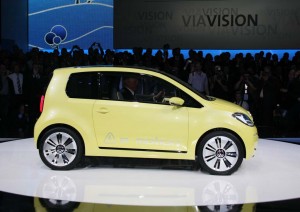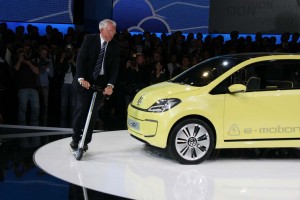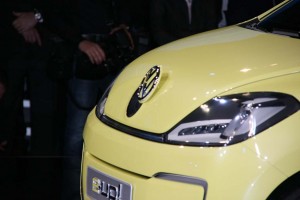
Volkswagen plans to put a version of this e-Up battery car concept, based on its Up minicar, into production by 2013.
Though there are bound to be some tweaks and changes made by the time a production version of the e-Up concept vehicle makes it into production, Volkswagen officials confirmed, during a preview of the 2009 Frankfurt Motor Show, that they will put the battery car into showrooms three years from now.
The e-Up is based on the new Up, one of the newest and decidedly the smallest members of the expanding VW line-up. Slightly smaller than the gasoline and diesel-powered versions of the minicar, the 2013 e-Up concept electric vehicle relies on a small set of Lithium-Ion batteries, mounted below its floor, to deliver a range of about 80 miles, enough for most urban drivers, according to Volkswagen officials.
“It is what we think a volume electric vehicle could look like in 2013,” declared Ulrich Hackenberg, the German maker’s technology chief, during a preview of the vehicles Volkswagen will be showing at the 2009 Frankfurt Motor Show.

Run out of battery power with the 2013 VW e-Up? No problem. Just pull out the e-Scooter, and keep on going. The car itself has an 80 mile range.
The e-Up concept’s front-drive powertrain produces about 80 horsepower and 155 pound-feet of torque, yielding an acceptable 0 to 60 time of about 11 seconds. To charge the e-Up, a motorist plugs it into either a conventional wall socket or higher-powered charging station through a port hidden unto the VW badge on the minicar’s hood.
(Adding a little whimsy — and a bit more range — the show car also features a specially-designed e-Scooter, which an e-Up owner could pull out of the minicar’s cargo bay.)
VW is still studying which battery technology to use, and is working with several potential suppliers, including Sanyo and China’s BYD, the world’s largest producer of cellphone and laptop computer LIon batteries. The e-Up would use flat, so-called prismatic, batteries, which can be fit into a tighter space than traditional cylindrical cells.
With the pace of change happening in LIon research, a lot could change by the time e-Up is ready for production, Hackenberg later told TheDetroitBureau.com. That could mean more powerful batteries and longer range. But VW is particularly hopeful that over the next few years, “the industrialization of production” of auto-sized LIon batteries would yield a significant dip in the price of the technology.

You would charge up the 2013 V e-Up by connecting a power supply to the socket hidden underneath the battery car's VW badge.
“Batteries are very expensive, right now,” said Hackenberg, “but with mass production, prices should go down.”
Like other manufacturers entering the battery field, VW is trying to gauge consumer sentiment, which could lead to significant changes in the design of a production e-Up. For one thing, if potential customers demand more range, the automaker would have to find a way to add more batteries.
Another question is whether consumers – and pedestrians – will appreciate the near silence of a running e-Up. As an alternative, Hackenberg flipped a switch and the concept vehicle revved a virtual engine whenever he stopped on the throttle. Some transportation experts fear that quiet electric vehicles could become a serious danger to pedestrians who might not notice an EV approaching them as they cross the road or ride a bicycle.
When e-Up hits showrooms, the battery-electric vehicle market will be in a rapid expansion mode. A variety of manufacturers, including Ford, Toyota and Mercedes-Benz, are promising to introduce their own BEVs by the early part of the coming decade.
How much demand there will be for such products is uncertain – with most expert cautioning that the ultimate answer will depend on matters such as pricing and range. But Hackenberg suggested that VW “expects the share for electric cars, by 2020, will reach 1.5 to 2.0%” of the global automotive market.
